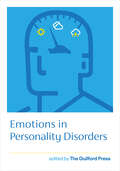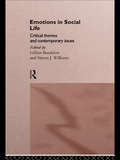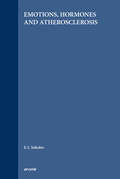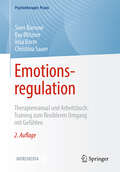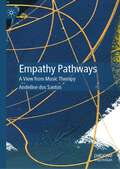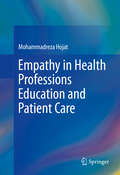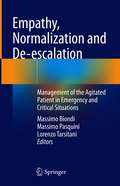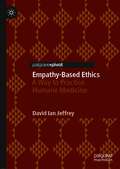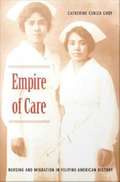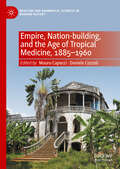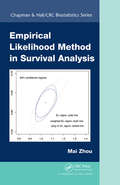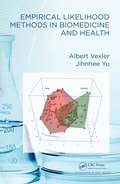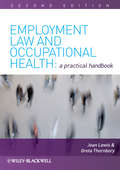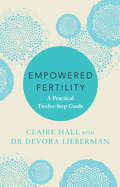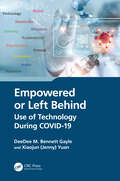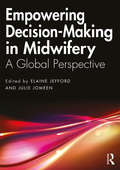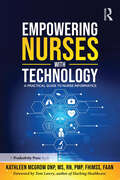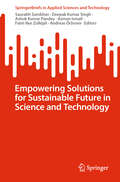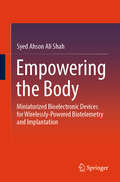- Table View
- List View
Emotions and the Right Side of the Brain
by Guido GainottiThis book focuses on asymmetries in brain structure and their role in emotional functions (such as amygdala in emotional comprehension, the ventro-medial prefrontal cortex in the integration between cognition and emotion and in the control of emotional reactions, and the anterior insula in the experience of emotions). The idea of hemispheric asymmetries in emotional comprehension and expression was first proposed about a century after the first studies showing that the left hemisphere is dominant for language, but it quickly became very popular. Initial investigations considered the right and left hemispheres as single functional units, but in the last few years several researchers have focused attention on asymmetries in brain structures playing a critical role in specific components of emotional functions. Furthermore, interesting data have been obtained by studying emotional and behavioural disorders of patients with asymmetrical forms of frontal or temporal variants of fronto-temporal degeneration. Elaborating on these subjects requires, on the one hand, a consolidated understanding of how models concerning the relationships between emotions and hemispheric asymmetries evolved in time and, on the other hand, a sound interdisciplinary knowledge of psychology (nature, components and hierarchical organization of emotions) and neuroscience (neuroanatomy). This volume – intended for neurologists, neuroscientists and psychologists – pursues an organic and consistent approach to provide an overview of these complex and fascinating issues.
Emotions in Personality Disorders
by The Guilford PressThis volume presents innovative clinical research programs and findings pertaining to emotions in personality disorders. Originally published in a Special Supplement of the Journal of Personality Disorders, chapters are written by a range of clinical experts. With a primary focus on borderline personality disorder (BPD), the book addresses such topics as personality function and emotional change in psychotherapy; how emotional dysregulation affects beliefs about emotion; shame as a core feature of BPD; the relationship between childhood adversity, affective lability, and alexithymia; and current directions in treatment.
Emotions in Social Life: Critical Themes and Contemporary Issues
by Simon J. Williams Gillian BendelowThe development of a sociology of emotions is crucial to our understanding of social life as they hold the key to our understanding of social processes and sociological investigation. First published in 1997, Emotions in Social Life consolidates the sociology of emotions as a legitimate and viable field of enquiry. It provides a comprehensive assessment of the sociology of emotions using work from scholars of international stature, as well as newer writers in the field. It presents new empirical research in conjunction with innovative and challenging theoretical material, and will be essential reading for students of sociology, health psychology, anthropology and gender studies.
Emotions, Hormones and Atherosclerosis
by SokolovThe increase of emotional stress has disturbing effects on the neurohumoral regulation of metabolic processes, especially in relation to the cardiovascular system, and increases the changes of organisms developing atherosclerosis. This book studies the effects on the cardiovascular system (in IHD patients) caused by emotions of diverse biological q
Emotionsregulation: Therapiemanual und Arbeitsbuch: Training zum flexibleren Umgang mit Gefühlen (Psychotherapie: Praxis)
by Sven Barnow Christina Sauer Eva Blitzner Insa BormMit diesem Manual bekommen Psychotherapeut_innen und Trainer_innen strukturierte Anweisungen an die Hand, um ein 9-wöchiges Training zur Förderung einer flexiblen Emotionsregulation durchzuführen. Neu in der zweiten Auflage: aktuelle Forschungsbefunde zur Emotionsregulation, Ergänzungen zur interpersonellen Emotionsregulation, entsprechende Anpassung der Gruppensitzungen und stärkerer Fokus auf das Training einer flexiblen Emotionsregulation. Die Anleitungen wurden zusätzlich mit praktischen Hinweisen angereichert. Aus dem Inhalt: Grundlagen flexibler Emotionsregulation – Gruppentraining in 9 Sitzungen mit Materialien – Training einzelner Regulationsstrategien – Evaluation – Abschluss und Booster. Das Autorenteam: Prof. Dr. phil. Sven Barnow, Leiter des Lehrstuhls für Klinische Psychologie und Psychotherapie, sowie der Psychotherapeutischen Hochschulambulanz an der Universität Heidelberg. Dr. phil. Eva Blitzner, Psychologische Psychotherapeutin (VT) in eigener Praxis für Psychotherapie und sozialmedizinische Gutachterin.Insa Borm, wissenschaftliche Mitarbeiterin in der Arbeitseinheit Klinische Psychologie und Psychotherapie an der Universität Heidelberg. Dr. Christina Sauer, Psychologische Psychotherapeutin (VT), wissenschaftliche Mitarbeiterin im Bereich der Psychoonkologie am Universitätsklinikum Heidelberg.
Empathie in de spreekkamer: Achtergronden, wetenschappelijke inzichten en praktische vaardigheden
by F.A.W.M. DerksenArtsen (in opleiding) richten zich steeds meer op persoonsgerichte zorg. Belangrijk onderdeel van die zorg is een goede communicatie met de patiënt. Huisarts Frans Derksen: “Uit gesprekken met patiënten, collegae huisartsen en wijkverpleegkundigen bleken veel problemen in de communicatie te ontstaan door een gemis aan empathie.” “Tijdens de jaren van onderzoek heb ik, als een soort bijwerking, veel geleerd over verschillende aspecten van het concept empathie. Veel van die aspecten passen niet in het keurslijf van een proefschrift maar vormen wel de inhoud van dit boek.” Ik wil laten zien waarom de thema’s rondom empathie een unieke waarde en een uniek belang hebben. Ik wil laten zien hoe dingen anders kunnen.” Dit boek bestaat uit een deel theorie, waarin wordt uitgelegd wat empathie is en wat de effecten zijn. Daarna wordt er een kort hoofdstuk gewijd aan empathie in verschillende medische, psychologische en sociale contexten. De kern van het boek vormen de vragen uit de praktijk, gesteld door de aios. Deel 4 bevat een beschouwing over hoe empathie in het vak en in het onderwijs gebruikt kan worden.
Empathy Pathways: A View from Music Therapy
by Andeline dos SantosMany descriptions of empathy revolve around sharing in and understanding another person’s emotions. One separate person gains access to the emotional world of another. An entire worldview holds up this idea. It is individualistic and affirms the possibility of access to other people’s “inner world.” Can we really see inside another, though? And are we discrete, separate selves? How can we best grapple with these questions in the field of music therapy? In response, this book offers four empathy pathways. Two are situated in a constituent approach (that prioritises discrete individuals who then enter into relationships with one another) and two are located in relational approaches (that acknowledge the foundational reality of relationships themselves). By understanding empathy more fully, music therapists, teachers and researchers can engage in ways that are congruent with diverse worldviews and ways of being. Examples used in the book are from active and receptive music therapy approaches as well as from community and clinical contexts, so as to provide clear links to practice. This book will be a valuable resource for academics and postgraduate students within music therapy and allied fields including art therapy, drama therapy, dance/movement therapy, psychology, counselling, occupational therapy and social development studies.
Empathy in Health Professions Education and Patient Care
by Mohammadreza HojatThis welcome updated and expanded edition offers new findings and insights into this cornerstone of practice as well as effective tools for its clinical use. Spanning psychodynamic theory to neuroscience and evolution to medicine, the book defines empathy in the context of patient care, and both in its critical role as a human attribute and in its necessity in promoting change and healing. Theory and data link practitioner empathy with patients' positive outcomes in areas such as provider trust, treatment adherence, clinical improvements, and quality of life. Author also provide convincing evidence in support of validity and reliability of the Jefferson Scale of Empathy for measuring the empathy of practitioners and students in the healing professions, and detail obstacles to developing and strategies for enhancing empathy among care providers. Among the topics covered: * Definition of empathy in patient care. * Conceptualization and consequences of empathy and sympathy in patient care. * An evolutionary perspective, sociophysiology, and heritability of empathy. * Measurement of empathy in the general population and in health professions-in-training, and in-practice. * Interpersonal dynamics in clinician-patient relationships. * Ten approaches to enhance empathy in Health professions education and patient care. * Exploration of neurological underpinnings of empathy. * Plus in-depth discussion of development, psychometrics, and correlates of the Jefferson Scale of Empathy. An essential text in theory and applications, Empathy in Health Professions Education and Patient Care enhances the work of health professions students, faculty, and practitioners in a variety of disciplines such as medicine, nursing, dentistry, psychology, clinical social work, and other health professions.
Empathy, Normalization and De-escalation: Management of the Agitated Patient in Emergency and Critical Situations
by Massimo Biondi Massimo Pasquini Lorenzo TarsitaniThis book describes theory and techniques of empathic communication, normalization and de-escalation procedures for the management of aggressive or violent patients in clinical critical settings'. Consisting of 9 chapters, it discusses in detail the self-regulation of empathy in potential dangerous interactions, as well as common mistakes and nonprofessional reactions. It also explores the basic concept of neurobiology of violence and aggression behaviour, such as brain circuitry and neuromodulators, and other rapid tranquillization guidelines. The final chapter focuses on the crucial topics of post-aggression debriefing.Based on the clinical experience of the editors and authors, who work in emergency psychiatry settings, the book offers practical key expressions to promote a normalization talk, to calm agitated individuals, and to prevent crises both for psychiatric patients and people without mental disorders.It is a useful tool to help readers gain confidence as mediators in critical circumstances and will be of interest for a wide range of practitioners in healthcare settings, from psychiatrists and psychologists, to nurses and other healthcare workers.
Empathy-Based Ethics: A Way to Practice Humane Medicine
by David Ian JeffreyThis book explores a new way of applying clinical ethics. Empathy-based ethics is based on the patient–doctor relationship and seeks to encourage a more humane form of medical practice. The author argues that the current emphasis on the biomedical model of medicine and a detached concern form of professionalism have damaged the patient–doctor relationship. He investigates examples of the dehumanization of patients and demonstrates a contrasting view of humane care. The book presents empathy as a relational construct - it provides an in-depth analysis of the process of empathizing. It discusses an empathy-based ethics approach underpinned by clinical examples of the practical application of this new approach. It suggests how empathy-based ethics can be embedded in clinical practice, medical education and research. The book concludes by examining the challenges in implementing such an approach and looks to a future which redresses the current imbalance between biomedical and psychosocial approaches to medicine.
Empire of Care: Nursing and Migration in Filipino American History
by Catherine Ceniza ChoyIn western countries, including the United States, foreign-trained nurses constitute a crucial labor supply. Far and away the largest number of these nurses come from the Philippines. Why is it that a developing nation with a comparatively greater need for trained medical professionals sends so many of its nurses to work in wealthier countries? Catherine Ceniza Choy engages this question through an examination of the unique relationship between the professionalization of nursing and the twentieth-century migration of Filipinos to the United States. The first book-length study of the history of Filipino nurses in the United States, Empire of Care brings to the fore the complicated connections among nursing, American colonialism, and the racialization of Filipinos. Choy conducted extensive interviews with Filipino nurses in New York City and spoke with leading Filipino nurses across the United States. She combines their perspectives with various others--including those of Philippine and American government and health officials--to demonstrate how the desire of Filipino nurses to migrate abroad cannot be reduced to economic logic, but must instead be understood as a fundamentally transnational process. She argues that the origins of Filipino nurse migrations do not lie in the Philippines' independence in 1946 or the relaxation of U. S. immigration rules in 1965, but rather in the creation of an Americanized hospital training system during the period of early-twentieth-century colonial rule. Choy challenges celebratory narratives regarding professional migrants' mobility by analyzing the scapegoating of Filipino nurses during difficult political times, the absence of professional solidarity between Filipino and American nurses, and the exploitation of foreign-trained nurses through temporary work visas. She shows how the culture of American imperialism persists today, continuing to shape the reception of Filipino nurses in the United States.
Empire of Pain: The Secret History of the Sackler Dynasty
by Patrick Radden KeefeThe highly anticipated portrait of three generations of the Sackler family, by the prize-winning, bestselling author of SAY NOTHING The Sackler name adorns the walls of many storied institutions: Harvard, the Metropolitan Museum of Art, Oxford, the Louvre. They are one of the richest families in the world, known for their lavish donations to the arts and sciences. The source of the family fortune was vague, however, until it emerged that the Sacklers were responsible for making and marketing OxyContin, a blockbuster painkiller that was a catalyst for the opioid crisis. Empire of Pain is a masterpiece of narrative reporting and writing, exhaustively documented and ferociously compelling.
Empire of Pain: The Secret History of the Sackler Dynasty
by Patrick Radden KeefeNEW YORK TIMES BESTSELLER • A NEW YORK TIMES NOTABLE BOOK OF THE YEAR • A grand, devastating portrait of three generations of the Sackler family, famed for their philanthropy, whose fortune was built by Valium and whose reputation was destroyed by OxyContin. From the prize-winning and bestselling author of Say Nothing."A real-life version of the HBO series Succession with a lethal sting in its tail…a masterful work of narrative reportage.&” – Laura Miller, Slate The history of the Sackler dynasty is rife with drama—baroque personal lives; bitter disputes over estates; fistfights in boardrooms; glittering art collections; Machiavellian courtroom maneuvers; and the calculated use of money to burnish reputations and crush the less powerful. The Sackler name has adorned the walls of many storied institutions—Harvard, the Metropolitan Museum of Art, Oxford, the Louvre. They are one of the richest families in the world, but the source of the family fortune was vague—until it emerged that the Sacklers were responsible for making and marketing a blockbuster painkiller that was the catalyst for the opioid crisis.Empire of Pain is the saga of three generations of a single family and the mark they would leave on the world, a tale that moves from the bustling streets of early twentieth-century Brooklyn to the seaside palaces of Greenwich, Connecticut, and Cap d&’Antibes to the corridors of power in Washington, D.C. It follows the family&’s early success with Valium to the much more potent OxyContin, marketed with a ruthless technique of co-opting doctors, influencing the FDA, downplaying the drug&’s addictiveness. Empire of Pain chronicles the multiple investigations of the Sacklers and their company, and the scorched-earth legal tactics that the family has used to evade accountability.A masterpiece of narrative reporting, Empire of Pain is a ferociously compelling portrait of America&’s second Gilded Age, a study of impunity among the super-elite and a relentless investigation of the naked greed that built one of the world&’s great fortunes.
Empire of the Scalpel: The History of Surgery
by Ira RutkowFrom a renowned surgeon and historian with five decades of experience comes a remarkable history of surgery&’s development—spanning the Stone Age to the present day—blending meticulous medical studies with lively and skillful storytelling.There are not many events in life that can be as simultaneously life-frightening and life-saving as a surgical operation. Yet, in America, tens-of-millions of major surgical procedures are performed annually but few of us pause to consider the magnitude of these figures because we have such inherent confidence in surgeons. And, despite passionate debates about healthcare and the endless fascination with surgical procedures, most of us have no idea how surgeons came to be because the story of surgery has never been fully told. Now, Empire of the Scalpel elegantly reveals the fascinating history of surgery&’s evolution from its earliest roots in Europe through its rise to scientific and social dominance in the United States. From the 16th-century saga of Andreas Vesalius and his crusade to accurately describe human anatomy while appeasing the conservative clergy who clamored for his burning at the stake, to the hard-to-believe story of late-19th century surgeons&’ apathy to Joseph Lister&’s innovation of antisepsis and how this indifference led to thousands of unnecessary surgical deaths, Empire of the Scalpel is both a global history and a uniquely American tale. You&’ll discover how in the 20th century the US achieved surgical world supremacy heralded by the Nobel Prize–winning, seemingly impossible feat of transplanting a kidney and how the heart-lung machine was developed, along with much more. Today, the list of possible operations is almost infinite—from knee and hip replacement to heart bypass and transplants to fat reduction and rhinoplasty—and Rutkow draws on his five-decade career to show us how we got here. Authoritative, captivating, and comprehensive, Empire of the Scalpel portrays the evolution of surgery in all its dramatic and life-enhancing complexity and shows that its history is truly one awe-inspiring triumph after another.
Empire, Nation-building, and the Age of Tropical Medicine, 1885–1960 (Medicine and Biomedical Sciences in Modern History)
by Mauro Capocci Daniele CozzoliThis book investigates the complex relationship between the development of modern empires, nation, and the history of tropical medicine. Broadening existing historiographical perspectives, it explores imperialism outside of the British Empire, drawing on case studies from other colonial experiences in Africa, Asia, and South America in the late-nineteenth and early-twentieth century. Each of these systems adopted different approaches to colonial health and medicine. By studying their diversity, it is possible to obtain a more comprehensive picture of what we now call ‘tropical medicine.’ The authors emphasise that the British model cannot be adapted to all colonial experiences, drawing on relevant cases from both interoceanic and continental empires. The collection comprises three sections. The first examines the role of tropical medicine in the evolution and collapse of empire in countries such as Portugal and the Netherlands. The second part analyses the links between tropical medical institutions and imperial commercial and political expansion in Britain and Brazil. Finally, the authors tackle the crucial interrelated circulation of people, objects, and ideas amongst countries including Brazil, China, Italy, and Spain. Using a medical lens to analyse the inter-connected processes of nation-building and colonial expansion in the late-nineteenth and early-twentieth centuries, this book provides valuable reading for scholars of imperialism and medical history alike.
Empirical Foundations Of Psychology (International Library Of Psychology Ser.)
by Pronko, N H & Bowles, J WFirst published in 1999. Routledge is an imprint of Taylor & Francis, an informa company.
Empirical Likelihood Method in Survival Analysis
by Mai ZhouEmpirical Likelihood Method in Survival Analysis explains how to use the empirical likelihood method for right censored survival data. The author uses R for calculating empirical likelihood and includes many worked out examples with the associated R code. The datasets and code are available for download on his website and CRAN.The book focuses on all the standard survival analysis topics treated with empirical likelihood, including hazard functions, cumulative distribution functions, analysis of the Cox model, and computation of empirical likelihood for censored data. It also covers semi-parametric accelerated failure time models, the optimality of confidence regions derived from empirical likelihood or plug-in empirical likelihood ratio tests, and several empirical likelihood confidence band results.While survival analysis is a classic area of statistical study, the empirical likelihood methodology has only recently been developed. Until now, just one book was available on empirical likelihood and most statistical software did not include empirical likelihood procedures. Addressing this shortfall, this book provides the functions to calculate the empirical likelihood ratio in survival analysis as well as functions related to the empirical likelihood analysis of the Cox regression model and other hazard regression models.
Empirical Likelihood Methods in Biomedicine and Health
by Albert Vexler Jihnhee YuEmpirical Likelihood Methods in Biomedicine and Health provides a compendium of nonparametric likelihood statistical techniques in the perspective of health research applications. It includes detailed descriptions of the theoretical underpinnings of recently developed empirical likelihood-based methods. The emphasis throughout is on the application of the methods to the health sciences, with worked examples using real data. Provides a systematic overview of novel empirical likelihood techniques. Presents a good balance of theory, methods, and applications. Features detailed worked examples to illustrate the application of the methods. Includes R code for implementation. The book material is attractive and easily understandable to scientists who are new to the research area and may attract statisticians interested in learning more about advanced nonparametric topics including various modern empirical likelihood methods. The book can be used by graduate students majoring in biostatistics, or in a related field, particularly for those who are interested in nonparametric methods with direct applications in Biomedicine.
Employment Law and Occupational Health: A Practical Handbook
by Joan Lewis Greta Thornbory'Employment Law and Occupational Health: A Practical Handbook' provides an essential guide to best practice for all occupational health practitioners. This readable guide to the law will help to ensure both business success and respect for individual employment rights. The cost of sickness absence can present major costs and business management problems. Safeguarding health is therefore vital to both individuals and employers. 'Employment Law and Occupational Health' explores key issues in occupational health practice from pre-employment, through health surveillance and occupational health services, to termination of employment. Topics explored include ethical and confidentiality issues, discrimination, data protection, working abroad, pregnancy and maternity leave, workplace policies, drugs and alcohol testing, stress, counselling, health surveillance and professional conduct rules. This second edition has been fully revised and updated to include a number of significant changes to employment law as well as new case law decisions that have occurred since the 1st Edition was published. Essential new material has also been included around age discrimination, disability discrimination, work related stress, corporate manslaughter and work-place bullying. An accessible, practical guide to applying health law in everyday practice. For occupational health nurses and other occupational health practitioners. Addresses key employment issues from pre-employment to termination of employment. Includes case studies, procedural checklists, and template letters and forms.
Empowered Fertility: The essential guide to managing fertility treatments and challenges, plus information about IVF
by Dr Devora Lieberman Claire HallInfertility can make women - and their partners - feel completely powerless. This clear, perceptive and incredibly helpful book enables women to empower themselves to not only deal with infertility but navigate the often difficult and confusing path through IVF.Written by experienced counsellor Claire Hall and fertility expert Dr Devora Lieberman, Empowered Fertility is a practical guide for women to help them cope with their psychological wellbeing, their emotions, family and friends and their attitudes during a very difficult time. It contains clearly structured and expressed information and offers women practical steps to assist them as they go through the processes of treatment for infertility. Each section of the book gives the reader information and support to address physical, psychological, emotional and social challenges that can arise when dealing with infertility and also with IVF treatment. Subjects include managing expectations, dealing with fear, releasing control and handling changes in relationships.The reader can work through at their own pace, making use of the coaching tools and exercises to help with each step. For readers who are starting or in the midst of IVF treatment, the last section of the book forms an IVF Cycle Handbook, to guide women through their experience.
Empowered or Left Behind: Use of Technology During COVID-19
by DeeDee M. Bennett Gayle Xiaojun (Jenny) YuanFocused on the United States, this book summarizes the secondary impacts of COVID-19 due to the increased use of technology. Establishing the global response of social distancing, mandates for non-essential business, and working from home, the book centers on the disparate guidance provided domestically at the state and local levels. Marginalized populations are highlighted to identify areas where technology facilitated access and reach or contributed to difficulties catapulted by digital literacy or digital access issues. To explain how people may have been empowered or left behind due to a new and unique reliance on technology, this book is structured based on the social determinants of health domains. Specifically, this book explains how technology was an umbrella domain that impacted every aspect of life during the pandemic including access, use, adoption, digital literacy, and digital equity, as well as privacy and security concerns. Given this book’s focus on the impacts to marginalized populations, there is a thread throughout the book related to the use of technology to perpetuate hate, discrimination, racism, and xenophobic behaviors that emerged as a twin pandemic during COVID-19. Part I explains the defining differences between primary and secondary impacts, as well as the unique guidelines adopted in each state. Part II of the book is focused on specific domains, where each chapter is dedicated to topics including economic stability through employment, education, healthcare, and the social/community context through access to services. Part III focuses on unique technological considerations related to COVID-19, such as mobile health-related apps and privacy or security issues that may have posed barriers to the adoption and use of technology. Finally, the book ends with a conclusion chapter, which explicitly explains the advantages and disadvantages of technology adoption during COVID-19. These exposed benefits and challenges will have implications for policies, disaster management practices, and interdisciplinary research.
Empowering Decision-Making in Midwifery: A Global Perspective
by Elaine Jefford Julie JomeenDecision-making pervades all aspects of midwifery practice across the world. Midwifery is informed by a number of decision-making theories, but it is sometimes difficult to marry these theories with practice. This book provides a comprehensive exploration of decision-making for midwives irrespective of where in the world they practice or in which model of care. The first part critically reviews decision-making theories, including the Enhancing Decision-making Assessment in Midwifery (EDAM) tool, and their relevance to midwifery. It explores the links between midwifery governance, including professional regulation and the law, risk and safety and decision-making as well as how critical thinking and reflection are essential elements of decision-making. It then goes on to present a number of diverse case studies, demonstrating how they interrelate to and impact upon optimal midwifery decision-making. Each chapter presents examples that show how the theory translates into practice and includes activities to reinforce learning points. Bringing together a diverse range of contributors, this volume will be essential reading for midwifery students, practising midwives and midwifery academics.
Empowering Nurses with Technology: A Practical Guide to Nurse Informatics
by Kathleen McGrowNursing informatics is the specialty that integrates nursing science with multiple information management and analytical sciences to identify, define, manage, and communicate data, information, knowledge, and wisdom in nursing practice. It allows nurses to deliver evidence-based and patient-centered care, improve human health, and advance medical research. It also enhances clinical workflows so that nurses and other personnel can care for patients more efficiently and effectively.Some of the benefits of nursing informatics include a reduction in medical errors, lowered costs, improved nurse productivity, and better care coordination among nurses, physicians, pharmacists, and others throughout various care stages. Empowering Nurses with Technology: A Practical Guide to Nurse Informatics is a comprehensive guidebook for nurses and healthcare professionals looking to understand the role of technology in modern nursing practices. This book covers the basics of healthcare technology, including electronic health records (EHRs), telehealth, and mobile health applications. This book offers practical advice for implementing technology in nursing workflows, as well as strategies for training and engaging nursing staff in the use of new technology. It also explores the impact of technology on patient care and outcomes, discussing topics such as patient safety, privacy, and data security.This book provides a useful resource for nurses seeking to leverage technology to improve the quality and efficiency of their care while also enhancing their professional development and job satisfaction.
Empowering Solutions for Sustainable Future in Science and Technology (SpringerBriefs in Applied Sciences and Technology)
by Andreas Öchsner Azman Ismail Ashok Kumar Pandey Fatin Nur Zulkipli Deepak Kumar Singh Saurabh SambhavThis book, embarks the reader on a journey into the forefront of innovation where science, engineering, and technology converge to address the pressing challenges of our time. Through a captivating exploration of cutting-edge research, real-world case studies, and visionary insights, this book illuminates the dynamic forces shaping our collective journey towards a more sustainable and prosperous future. The book also explores how breakthroughs in science, engineering, and technology are reshaping our world for the better. This book is beneficial for research scholar, undergraduate and postgraduate students, or industry staff. The book inspires and empowers readers to become catalysts for positive transformation in our communities and beyond.
Empowering the Body: Miniaturized Bioelectronic Devices for Wirelessly-Powered Biotelemetry and Implantation
by Syed Ahson ShahEmbark on a groundbreaking journey into the realm of miniaturized bioelectronic devices with "Empowering the Body." This captivating book delves into the world of wirelessly-powered biotelemetry and implantation, offering unparalleled insights into the future of healthcare monitoring. Discover the motivations driving the development of wireless implantable medical devices (WIMDs) and the challenges faced in their design. Unravel the mysteries behind biocompatibility, size miniaturization, patient safety, and impedance mismatches. Witness the innovative solutions that optimize performance and extend battery life, all while ensuring the utmost precision in therapy and treatment. Featuring state-of-the-art research, this book showcases cutting-edge advancements in miniaturized implantable antenna systems, ultra-small batteryless WIMDs, and deeply implanted stent antenna systems for endovascular aneurysm repair. Immerse yourself in a world of simulations, numerical analyses, and validation experiments, where the proposed systems are rigorously tested and proven to excel in heterogeneous human body tissue environments. "Empowering the Body" caters to a diverse audience of researchers, engineers, and medical professionals at the forefront of bioelectronic devices and wireless power transfer. Whether you're an expert in the field or a graduate student seeking knowledge, this book is your key to unlocking the potential of wireless healthcare solutions. Open the pages of this exceptional book and explore its unique approach, combining theoretical insights with practical applications. Gain a comprehensive understanding of how to overcome the limitations of current technologies, and be inspired by the possibilities that lie ahead. Don't miss your chance to be at the forefront of the biomedical revolution with "Empowering the Body."

